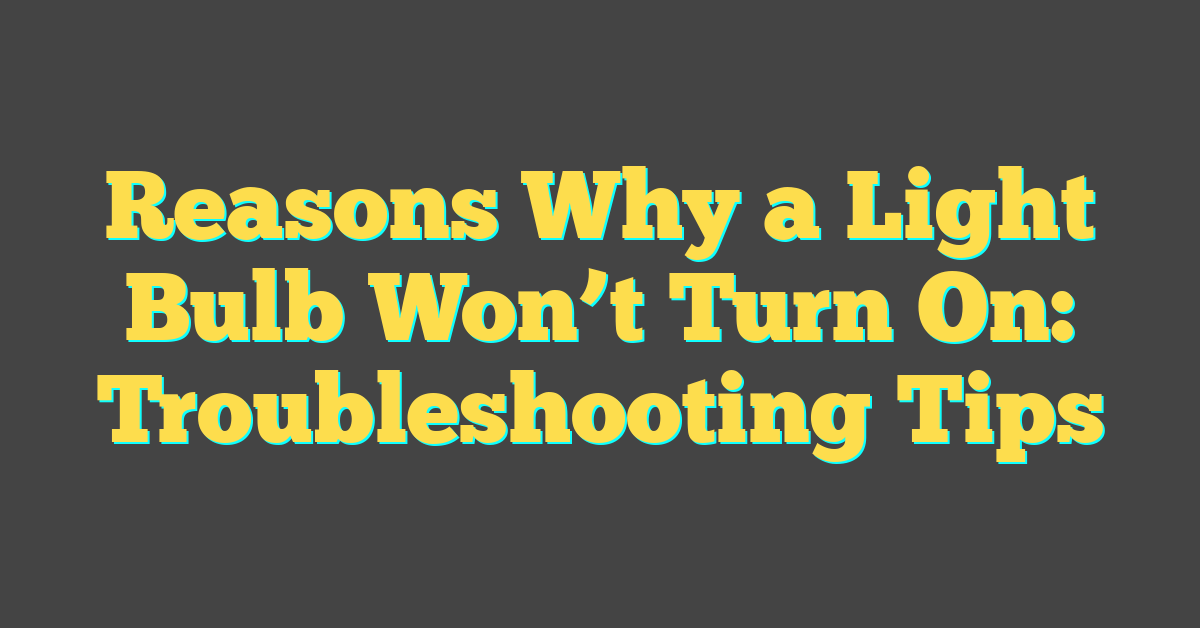When a light bulb won’t turn on, it’s a minor inconvenience that hints at various potential issues waiting to be addressed. Most of the time, the solution is simple and something you can handle without much effort. Whether it’s a flickering light or complete darkness, understanding the root cause is the first step in bringing back the light to your room.


Assessing why a light bulb has failed involves looking into several factors that range from the very obvious to the more complex. A burnt-out bulb, for instance, is a common culprit and one of the easiest to fix. Sometimes, however, the issue may not be with the bulb itself but with the power supply—such as a tripped circuit breaker or a faulty wall switch. If the quick fixes don’t work, it might be time to inspect the wiring or consider whether it’s a job for a professional.
Key Takeaways
- Simple issues like a burnt-out bulb can often be fixed without help.
- Problems beyond the bulb may involve the power source or fixtures.
- If basic troubleshooting doesn’t work, professional help may be needed.
Common Causes of Light Bulb Failure

When your light bulb won’t turn on, it can be due to a few common issues. Understanding what might be behind the failure can help you decide whether to attempt a fix yourself or call an electrician for repair.
Burned-Out Bulbs
Burned-out bulbs are the most frequent culprits when a light stops working. A bulb has a finite lifespan, and once it has reached the end, it will no longer illuminate. To discern a burned-out bulb, look for a darkened top or a broken filament inside. Always handle bulbs carefully when investigating or replacing them.
Incompatible Bulb Wattage
Selecting bulbs with the correct wattage is crucial, as using bulbs with wattage too high for the fixture can lead to malfunctions. This is due to the excess heat generated by a higher wattage bulb, which can damage the fixture or bulb itself. Verify the maximum wattage on your fixture and ensure your bulb matches to prevent this issue.
Faulty Wiring or Connections
Loose or faulty wiring and connections can prevent bulbs from turning on. If the bulb is not the issue, inspect your fixture’s wiring and look for any loose connections. It’s essential to turn off the electricity to the fixture before touching any wires. If you’re unsure, it’s best to consult an electrician, as improper handling of wiring can be dangerous.
Troubleshooting the Power Source

To get your light bulb working, it’s important to start by checking the power source. This means ensuring that electricity is successfully reaching your light bulb. Let’s dive into how you can troubleshoot potential issues with the power supply to your light fixture.
Issues with the Circuit Breaker
Your circuit breaker manages the flow of electricity in your home. If a light won’t turn on, first check your circuit breaker box—it might have tripped, cutting off power to the light circuit. Look for a switch that’s flipped to the “off” position or is in a middle position and flip it back on to reset the circuit.
- Look for switches labeled with the room or area of the non-functioning light.
- If a breaker trips frequently, there may be an underlying electrical issue that requires a professional electrician.
Problems with the Light Switch
The problem could be with the wall switch controlling your bulb. An easy test is to:
- Turn off the switch.
- Remove the switch plate and use a multimeter to check for continuity.
- If the switch is faulty, you’ll need to replace it.
Always ensure you turn off the power at the circuit breaker before inspecting the switch to avoid electrical shock.
Complications with Outlets and Plugs
If you’re dealing with a lamp, the issue might be with the outlet or plug. Double-check to see if the plug is firmly seated in the outlet. An unsecured plug can lead to an incomplete electrical connection, preventing your light from turning on. Here’s what to check:
- Ensure the outlet is functioning by plugging in another device.
- Inspect the plug for signs of damage, such as bent prongs or fraying wires.
If other devices don’t work in the same outlet, you may need to replace the outlet or look for issues deeper in your home’s electrical system.
Checking the Light Fixture
« Yellow Light Bulbs vs White for Bugs: Which Attracts Fewer Insects?
Most Healthy Light Bulbs: Choosing the Best for Your Well-being »
https://www.youtube.com/watch?v=iSiaxWJ0veI&embed=true
When your light bulb won’t turn on, the fixture itself could be the culprit. It’s essential to examine components like the socket, lamp, and fixture for faults to get your light functioning again.
Socket Issues
The socket tab inside the socket is a common problem area. It should be making firm contact with the base of the light bulb. If the tab is too low, it may not touch the bulb, leading to a lack of power. Carefully bending the tab upwards can restore contact, but ensure the light is turned off before you attempt this. If you’re not comfortable with this step, it’s best to consult an electrician to avoid further damage or risk.
Lamp and Fixture Faults
Inspect the lamp and light fixtures for any visible signs of damage, such as frayed wires or cracks. Sometimes the cord or plug could be at fault, and in that case, the whole fixture might need attention or replacement. These instances usually require the skills of a professional. It’s also worth noting that if replacing the light bulb does not resolve the issue, the problem likely lies within the lamp or fixture itself, pointing to the need for repair or replacement.
Worn Out or Damaged Sockets
With time, sockets can become worn out or damaged. Signs of a faulty socket include burn marks, corrosion, or malfunction when you try to screw in a new bulb. The best action is often to replace the light bulb with a new one to see if that solves the issue. If not, the socket may need to be replaced, a task that might require an electrician’s expertise, especially if you’re unsure about handling electrical components.
Steps to Replace a Light Bulb

When your light bulb burns out, the right replacement and proper installation are key to lighting up your space again. Here’s a friendly guide to walk you through the process.
Choosing the Right Bulb
When it comes time to replace your light bulb, check the fixture for the maximum wattage it can handle and choose a bulb that matches or is lower; going higher can be a safety hazard. LED bulbs are a great option because they’re energy-efficient and long-lasting. Here’s a quick checklist:
- Wattage: Ensure the new bulb doesn’t exceed fixture wattage.
- Voltage: Match the voltage of the old bulb to avoid electrical issues.
- Type: Compact fluorescent (CFL), LED, or halogen? Choose based on your needs.
- Fit: Make sure the bulb base fits your fixture.
Ensuring Proper Installation
Correctly installing the bulb is crucial. First, always turn off the power to the fixture to avoid electric shocks. For a lamp, unplug it. For a ceiling fixture, turn the switch to the off position. Here’s what to do next:
- Remove the old bulb by unscrewing it counter-clockwise.
- Inspect the socket for damage. Look for signs of corrosion or wear.
- Screw in the new bulb gently but firmly until snug. Don’t overtighten.
- Restore power and test the light to ensure it works.
Remember, handling bulbs gently is crucial as they can be fragile. If you’re replacing a burned-out light bulb with an LED bulb, you’ll enjoy not only better energy efficiency but often a longer lifespan, meaning you’ll have to do this less often!
Understanding Electrical Terms

When trying to figure out why your light bulb won’t turn on, you need to be familiar with a few basic electrical terms. These are important because they can affect the compatibility and performance of your light bulbs.
Voltage and Wattage Explained
Voltage refers to the pressure from an electrical circuit’s power source that pushes charged electrons (current) through a conducting loop, enabling them to do work such as illuminating a light bulb. Your home’s outlets are typically supplied with a standard voltage (in the United States, it’s usually 120 volts).
- High Voltage: Risk of overpowering and burning out the bulb.
- Low Voltage: May result in dim lighting or no illumination.
Wattage indicates the energy consumption of a bulb. The higher the wattage, the more electricity it uses. However, with LED bulbs, more wattage doesn’t always mean it’s brighter, due to their efficiency.
- High Wattage: Can cause overheating if it exceeds fixture rating.
- Low Wattage: Uses less electricity and is usually dimmer.
Evaluating Bulb Types
Different bulbs have varying requirements and characteristics; understanding these can help you troubleshoot lighting issues.
- Traditional Incandescent Bulbs: Typically use more wattage and have a lower lifespan.
- LED Bulbs: Use less wattage for the same level of brightness and last much longer.
Always remember to match your bulb’s wattage to what your fixture can handle to avoid electrical problems. Also, check if your bulb is meant for the voltage supplied to your light fixture to prevent any malfunctions.
When to Call a Professional

Sometimes, despite your best efforts to troubleshoot a light bulb issue, you may reach a point where it’s safer and more efficient to call in a professional. The complexity of electrical systems means that some problems are best left to those with specialized training.
Recognizing Complex Issues
- Electrical Odors: If you detect a burning smell near your light fixtures, switches, or sockets, it’s time to consult a professional electrician.
- Faulty Wiring: Flickering lights or circuit breakers that frequently trip could be signs of deeper electrical issues.
Benefits of Hiring an Expert
- Safety: An expert can safely manage electricity-related risks.
- Quality Repair: A certified electrician is equipped to deliver a lasting solution.
Safety Precautions

Before attempting any troubleshooting or repairs with a light bulb that won’t turn on, your safety is paramount. It’s crucial to handle electricity with respect and care to avoid any risks.
Working with Electrical Components
- Turn Off Electricity: Always turn off the power at the circuit breaker or fuse box before touching any electrical wiring or components.
- Use the Right Tools: Equip yourself with a non-contact voltage tester to check for live circuits, and use insulated tools to protect against accidental shocks.
Avoiding Common Hazards
- Inspect Cords: Ensure that any cord you use is free from damage, such as fraying or cuts, and is properly rated for the electrical load.
- Stay Comfortable: Work in a well-lit and comfortable area to avoid physical strain and maintain a clear view of what you are doing, which helps in avoiding accidental hazards.
Maintenance Tips

Before getting into specifics, it’s important to regularly inspect your light bulbs and fixtures. These checks can prevent common issues and extend the life of your lighting components.
Regular Checks and Balances
Light Bulbs:
- Inspect your bulbs frequently for signs of dark spots or flickering, which indicate it’s time for a replacement.
- Ensure that bulbs are screwed in firmly; a loose bulb can cause intermittent or no lighting.
Light Fixtures:
- Dust and clean your fixtures monthly to prevent dust accumulation that can diminish light output or pose a fire hazard.
- Check the fixture wiring occasionally for frayed cords or loose connections that need attention.
Longevity of Bulbs and Fixtures
Bulbs:
- Opt for bulbs with a longer lifespan, such as LEDs, which can offer better energy efficiency and reduce the frequency of replacements.
- Use the correct wattage for your fixture to avoid overheating and potential damage to both the socket and the light bulb.
Fixtures:
- If a light fixture frequently burns out bulbs, it may indicate a more serious problem with the socket or fixture itself.
- Consider upgrading older fixtures to newer models designed for improved energy efficiency and better compatibility with LED bulbs.
Advanced Troubleshooting Techniques
https://www.youtube.com/watch?v=n9EJHbAQujE&embed=true
When you’ve tried the simple fixes and your light bulb still won’t illuminate, it’s time to look a bit deeper. These advanced techniques will help you diagnose issues that go beyond the basics, such as complex circuitry and problematic sockets or switches.
Diagnosing Complex Circuitry
Complex circuitry requires a systematic approach. Use a multimeter to check for continuity and ensure that the circuit isn’t broken. It’s critical to test both the live and neutral wires for potential faults. If there is a problem within the wiring of your home, it may be an issue with your circuit breakers. Check to see if any breakers are tripped or if there’s a blown fuse, which could hinder power from reaching your light fixture.
Analyzing Socket and Switch Problems
The problem sometimes lies within the socket or the switch. For sockets, carefully examine them for signs of damage or corrosion, which can prevent a bulb from getting a good electrical connection. To analyze switch issues, especially with in-line or wall switches, listen for unusual sounds like crackling or sizzling, which indicate the contacts may be worn out. Using a non-contact voltage tester after turning off the power, you can safely check for voltage presence at both the socket and the switch. If your switch is the culprit, it may require replacement by a qualified electrician. Remember, handling electrical components can be dangerous, and if you’re unsure, always call a professional.
The Role of Light Bulbs in Home Comfort
https://www.youtube.com/watch?v=B-trr2suQiM&embed=true
Choosing the right light bulbs is key to creating a comfortable space in your home. The type of bulb and the light it emits can dramatically affect both your home’s ambiance and energy consumption.
Impact on Ambiance
Your choice of light bulb has a significant impact on the mood and atmosphere of a room. For a cozy feel, soft and warm lighting works best, often provided by LED bulbs that mimic the warm glow of incandescent bulbs. Bright white light, on the other hand, may be ideal for work areas, where clarity and visibility are essential. The ability to adjust brightness with dimmable LED options also allows you to tailor lighting to your specific comfort needs at different times of day.
Influence on Energy Consumption
LED bulbs are not just about setting the right mood; they’re also about efficiency. In terms of energy consumption, LEDs are a smart choice for your home. They use up to 85% less energy than traditional bulbs and last up to 25 times longer. This means you can enjoy a comfortable ambiance in your home without worrying about frequent bulb replacements or high electricity bills. By choosing LEDs, you’re opting for a sustainable solution that benefits both your comfort and your wallet.
DIY Repairs and When to Avoid Them

When facing a light bulb that won’t turn on, certain repairs can be done yourself with basic tools. However, it’s important to know when a problem is beyond your skill set to avoid safety hazards.
Identifying Doable Fixes
- Bulb Replacement: Start by swapping out the old bulb with a new one to see if that’s the culprit.
- Socket Tab Adjustment: Sometimes, the little metal tab in the socket is depressed; you can gently pry it up with the power off.
- Wire Connections: Check if the wire connections are secure and not frayed, but be sure to turn off the power first.
Risks of Self-Repair
- Electrical Shock: Always disconnect power before attempting to fix any electrical components.
- Fire Hazards: Incorrectly managing wire connections or dealing with frayed cords can create serious fire risks.
- Complex Wiring Issues: Problems in wiring could signal deeper electrical issues that require a professional.
While you can manage simple fixes like changing bulbs or adjusting the socket tab, approach any repair involving wiring or frayed cords with caution. When in doubt, consult a licensed electrician to ensure safety and proper repair.




